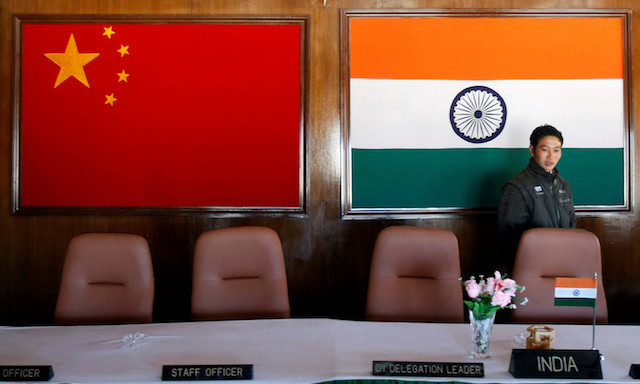Popular Reads
Top Results
Can't find what you're looking for?
View all search resultsPopular Reads
Top Results
Can't find what you're looking for?
View all search resultsWhy are Chinese and Indian troops fighting in a remote Himalayan valley?
Change text size
Gift Premium Articles
to Anyone
 A man walks inside a conference room used for meetings between military commanders of China and India, at the Indian side of the Indo-China border at Bumla, in the northeastern Indian state of Arunachal Pradesh, in this Nov. 11, 2009 file photo.The Indian army has said at least 20 of its soldiers were killed after hand-to-hand fighting with Chinese troops at a disputed border site on Monday night, in the deadliest clash between the two Asian giants in decades. (Reuters/Adnan Abidi)
A man walks inside a conference room used for meetings between military commanders of China and India, at the Indian side of the Indo-China border at Bumla, in the northeastern Indian state of Arunachal Pradesh, in this Nov. 11, 2009 file photo.The Indian army has said at least 20 of its soldiers were killed after hand-to-hand fighting with Chinese troops at a disputed border site on Monday night, in the deadliest clash between the two Asian giants in decades. (Reuters/Adnan Abidi)
T
he Indian army has said at least 20 of its soldiers were killed after hand-to-hand fighting with Chinese troops at a disputed border site on Monday night, in the deadliest clash between the two Asian giants in decades.
China said its troops were engaged in a "violent physical confrontation" with Indian soldiers, but has given no details of those killed or wounded.
The Indian army and India's foreign ministry have said both sides suffered casualties after their troops clashed, even as the two countries were trying to resolve a weeks-long border standoff.
Here are the key details:
Where was the fighting?
The clashes took place at a disputed border site in the Galwan area of Ladakh, in the western Himalayas, where Indian and Chinese troops have been facing off. The area is at an altitude of around 14,000 feet, where temperatures often fall to under zero degrees Celsius.
The disputed site lies amid remote jagged mountains and fast flowing rivers on the northern tip of India, abutting the Aksai Chin plateau that is claimed by India but is administered by China.
What happened?
Since early May, hundreds of Indian and Chinese soldiers have confronted each other at three locations along their border, each side accusing the other of trespassing.
The clashes at Galwan took place on Monday night even as both armies were trying to de-escalate the stand-off, with military commanders having met for talks in recent days.
During discussions, soldiers from China's People's Liberation Army turned on a group of Indian troops, which included an officer, attacking them with iron rods and stones, an Indian government source said.
No shots had been fired, the source said.
India's foreign ministry spokesman Anurag Srivastava said that the "violent face-off" was the result of an attempt by the Chinese side to unilaterally change the status quo.
Chinese officials said that Indian troops had twice crossed the Line of Actual Control (LAC), the de facto border, and launched an attack, triggering a fierce physical confrontation.
Zhao Lijian, a Chinese foreign ministry spokesman, said that "the Indian side severely violated our consensus and twice crossed the border line and provoked and attacked the Chinese forces."
Why now?
Military experts say one reason for the current face-off is that India has been building roads and airfields to improve connectivity and narrow the gap with China's superior infrastructure on its side of the LAC.
At Galwan, India completed a road leading to an airfield last October. This was opposed by China, which asked India to stop all construction.
India says it is operating on its side of the LAC.
History of clashes
A past agreement between the two sides stipulates patrols should not open fire near the LAC. Violent, high-altitude disputes have erupted several times without guns being involved.
The deaths were the first since a major border clash in 1967 between the nuclear-armed neighbors, which are also the world's two most populous countries. Hundreds were killed in those battles.
Both countries claim vast swathes of each other's territory along their Himalayan border, with some disagreements rooted in demarcations by British colonial administrators of India.
India and China fought a brief but bloody border war in 1962 and distrust has occasionally led to flare-ups ever since. Infrastructure building near or within disputed territories is often blamed for increases in tensions.
The LAC is largely based on the ceasefire line after the war in 1962, but both sides disagree on where it lies.
The last major dispute took place in 2017 on the remote Doklam plateau near the borders of India, Bhutan, and China, at the eastern end of the 4,056 kilometer long border. After a tense standoff both sides agreed to an "expeditious disengagement" of troops, according to India's foreign ministry.









